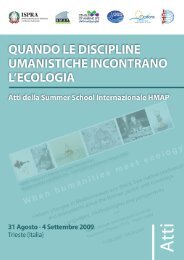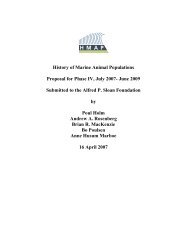The Danish fisheries c.1450-1800. Medieval and early modern ...
The Danish fisheries c.1450-1800. Medieval and early modern ...
The Danish fisheries c.1450-1800. Medieval and early modern ...
Create successful ePaper yourself
Turn your PDF publications into a flip-book with our unique Google optimized e-Paper software.
<strong>and</strong> the North Sea in the west was breached by a flood in 1624 <strong>and</strong> 1825. We know that the<br />
fish catches went up in the years immediately after the second breach, <strong>and</strong> that may also have<br />
happened in the 1620s. However, by 1630 <strong>and</strong> 1832 the <strong>fisheries</strong> were reported to be much<br />
depressed. <strong>The</strong> herring, which was accustomed to brackish water, was probably severely<br />
reduced with the intrusion of salt water. In the 1630s, the dune barrier was built up by the<br />
natural s<strong>and</strong> drift along the North Sea coast, <strong>and</strong> the herring stock regained strength. 34 <strong>The</strong><br />
process would perhaps have repeated itself in the nineteenth century had it not been for<br />
dredging <strong>and</strong> coastal works to keep the fiord open. <strong>The</strong> decadal cycle of the fishery which<br />
may be detected from the 1670-1750 series may also wholly be explained as a biological<br />
pattern, while the depression of the Limfjord fishery in the late eighteenth century may partly<br />
be explained as an economic result of overwhelming Bohuslen exports in the 1760s, but we<br />
should note the long-term decline which had begun already by the 1730s.<br />
<strong>The</strong> periodicity of the Bohuslen herring implies that environmental forcing was the<br />
major underlying factor, while it has been argued above that the sudden cessation of the<br />
fishery in 1590 was have been linked to market factors. <strong>The</strong> alternating cycles of North<br />
European pelagic stocks seem to be correllated to the North Atlantic Oscillation, <strong>and</strong> the<br />
historical data for the Bohuslen herring stock is one of the best examples of this correllation.<br />
<strong>The</strong> most probable explanation, which parallels the experience from the nineteenth-century<br />
herring fishery on the same resource, 35 is that the herring shoals preferred spawning grounds<br />
outside the reach of the inshore fishermen. If, because of a change in salt concentration,<br />
spawning suddenly took place in the middle of the Skagerrak rather than in the sheltered<br />
archipelago of Bohuslen, the shorebound <strong>Danish</strong> <strong>and</strong> Norwegian fishermen may have found it<br />
impossible to catch the herring. In order to go deep-sea fishing they would have needed<br />
34 Danske Magazin 3:4, 329-332.<br />
35 See Holm, Kystfolk, chapter 7.






